County heritage of apples worth preserving
Donald McClure | Nov 04, 2010 | Comments 6
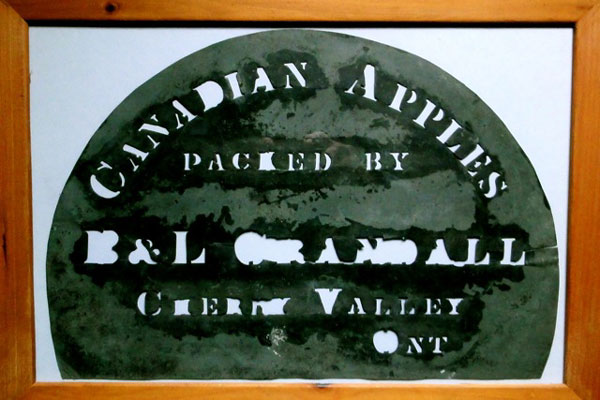
Crandles Orchard was located along the shore of East Lake near Cherry Valley, I understand.Preserved stencil has lost some of its detail. Donald McClure photo
By Donald McClure
One of the lingering memories of this autumn and autumns past is our annual visit to Waupoos to stock up on apples. Standing in Creasy’s retail shed a few weeks ago surrounded with baskets and bins of freshly harvested apples, seems almost to be a right of passage for County folks. It links us with our heritage and the great privilege it affords to have such a gleaming bounty heaped in our midst.
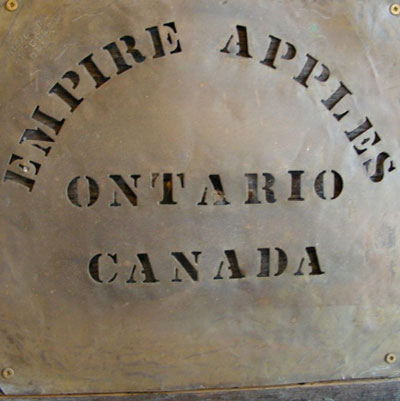
Stencil from Empire Apples used on apple boxes or barrels. Anyone remember where they were located? Donald McClure photo
For where else can you fill up a hamper with Cox’s Orange Pippins, Talman Sweets, Snows, Empires, Northern Spies, Crispins, and of course McIntosh and many others and smell the fragrance of Ontario apples straight off the trees. The mouth starts to water just thinking about the tart sweetness of one of these crisp apples on your tongue.
This is what County life is all about. This is the produce of our soil and the promise of our heritage. But gosh it has to be looked after by all of us — including the government.
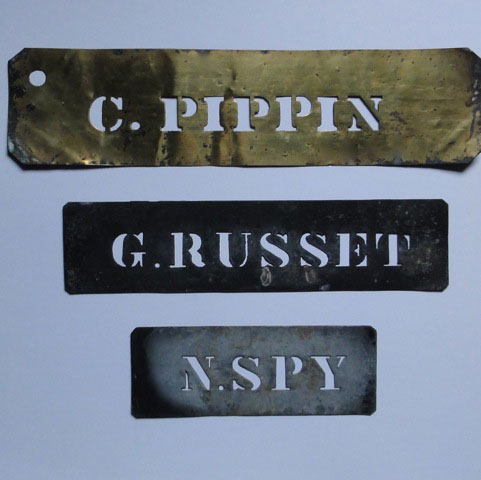
Stencils were made from brass, galvanized steel and zinc. This collection found locally were for Cox's Orange Pippin ( Benjamin Franklin grew early Pippins), Golden Russet, and Northern Spy. Donald McClure photo
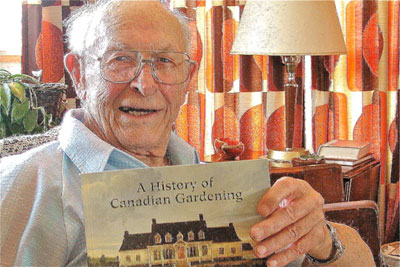
Kindly apple fancier who grew over 160 apple varieties the late Henry Gray was a County fixture. Donald McClure photo
Harvest is also when I think of the friendly smile of Henry Gray who left us in February 2002. At the apex of his apple-growing prowess Henry had more than 100 trees on his five acre property on Glenora Road, many grafted with multiple varieties. In all he could list 160 types of apples including nine varieties of Russet and four of Pippins.
It was dedication like his that helped to sustain some of the rare and traditional types of apples we still have with us today. Too often old varieties are allowed to vanish from our orchards. I still think of the Red Astrachan which stood near the rocky hill behind my grandfather’s property. It produced a good crop every other year and we couldn’t wait to pick a ripe one out of the tree. But do any of these old Russian varieties still survive in Ontario? For Henry Gray and others like him, saving rare species was a labour of love.
Today apples are often grown for appearance and shelf sustainability. Taste is sometimes lost in the pursuit of appearance. When we were growing up the most popular cooking apples were Greenings (Henry grew both Bottle and Rhode Island varieties). Today the name is seldom recalled. The most popular Boy Scout apples in my day were Snows which appeared in barrels in the Church basement for filling our tag-day baskets. These have been long replaced with more rugged but possibly more bland varieties.
If I could only have one apple it would likely be the Northern Spy — which I find is useful for both eating and cooking. Some people say that they rate the short season and fickle Macoun (cross between a Mac and a Jersey Black) as the best eating apple.
The Mac was discovered of course by Loyalist John McIntosh in Dundas County down near Brockville in 1811. Today, apples still remain our top tree fruit crop in Canada. But we have to be vigilant to sustain this industry because different marketing circumstances, relatively low prices, lack of government support and imports of apple products from overseas have been eroding this industry. In the past decade numerous orchards in Ontario have been abandoned or eradicated — the land planted with other crops.
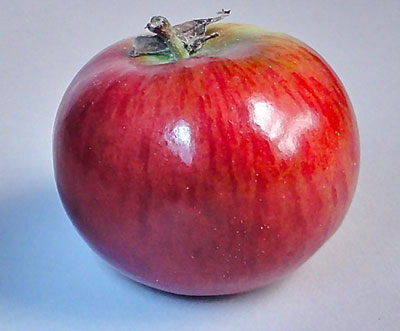
Loyalist John McIintosh used the glorious old Snow to hybridize iconic McIntosh. This Snow from a Waupoos orchard. Donald McClure photo
Anyway, the point of this discourse today is to point out that some of the cultural emblems of our apple industry have almost disappeared from the scene. When I originally twigged to the idea of picking up a few of the old working apple stencils from local antique shops it would appear that most of them had been snapped up and unfortunately many I would think have been carried away from the County. There are probably a some still lying neglected in old barns, but many simply disintegrated from over use or neglect.
Those that remain are like sign posts telling us a story of a day when the shipping of barrels of apples put our name on display in distant markets.
If you have any apple collections let us know.
Read more from The County Gardener Donald McClure
Filed Under: Featured Articles
About the Author: He can tickle your funny bone or tug at your heart strings. County people may know him as a chronicler of everything that happens (or should happen) in the garden, but his interests stretch across the natural world. His unique sense of observation takes in a wide expanse of living and may even point out some truths about our own condition as managers of the world around us. With Loyalist antecedents in his family tree his roots go deep into the Ontario countryside.
































Good morning Dawn. Last week while shopping for apples before the orchards close up shop for the winter one proprietor cut up a Russet apple for us and invited us to sample the delicate flavour. Her advice was to store these apples properly for a few weeks and we would discover that the flavour is enhanced by the storage process. There is some excellent advice on the subject on the internet at :http://www.backwoodshome.com/articles/fallick41.html
Key to apple storage is to use thicker skinned apples, wrapped in newspapers and
protected from bruising or contact with other fruit. Good luck!
Delighted to hear of your orchard Andrew — and Astrachans in the bargain! Would love to drop by next spring when the trees are in bloom and take some pictures and talk about apples. Thank you so much for letting me know and best wishes for much success. Regards
Do you have any suggestions Donald for the best ideas to cook and store your apples over the winter?
Dear Donald,
You may be happy to know that I’ve recently planted more than twenty older varieties of apples at our place on Closson road with a total of about 120 trees on a trial basis to see which do well here. Amongs the types of apples I have four Red Astrachan trees(!), several Pippins and Russets, and many other interesting so-called old-fashioned varieties…
Couldn’t agree with you more Louisa! But considering our orchard managers today face growing imports of both apples and concentrate, central buying by retailers which may favour cheaper apples from outside the country and in many cases developed orchards which may not be as productive as some of the newer
orchards south of our border, I still think that our domestic producers are putting out a pretty special product and we must support their efforts.
Thank you for your comments
You’re right, I’ve not heard of Greenings apples. My favourite has been empire, which I understand is a cross between MacIntosh and Delicious. But since my husband and I picked a $3.00 basket of windfalls at a Waupoos orchard a couple weeks ago of Spartans, I find they could top the empires! I made a huge batch of applesauce with the Spartans, and actually we ate a lot of them as is, too, as they were just fine and crunchy even for having fallen from the tree. I laugh when I see apples in the grocery store from Chile, when we have so many in our backyards here.